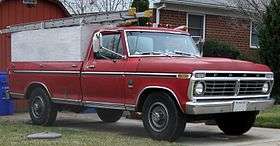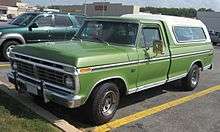Ford F-Series sixth generation
| Sixth generation | |
|---|---|
 | |
| Overview | |
| Manufacturer | Ford |
| Production | 1972–1979[1] |
| Assembly |
Dearborn, Michigan, USA Edison, New Jersey, USA Kansas City, Missouri, USA Louisville, Kentucky, USA Norfolk, Virginia, USA San Jose, California, USA St. Paul, Minnesota, USA Wayne, Michigan, USA Cuautitlan, Mexico General Pacheco, Argentina (Ford Argentina) Oakville, Ontario, Canada (Oakville Assembly) |
| Body and chassis | |
| Class | Full-size pickup truck |
| Body style | 2 to 4 door pickup |
| Layout | Front engine, rear-wheel / four-wheel drive |
| Related |
Ford Bronco Ford B-Series |
| Powertrain | |
| Engine |
240 CID (3.9 L) I6 300 CID (4.9 L) I6 360 CID (5.9 L) FE V8 390 CID (6.4 L) FE V8 460 CID (7.5 L) 385 V8 351 CID (5.8 L) 351M V8 400 CID (6.6 L) 335 V8 203 CID (3.3L) Perkins 4.203 4-cylinder Diesel (an option exclusive for the Argentinian-assembled F-100) |
| Chronology | |
| Predecessor | Ford F-Series fifth generation (1966–1972) |
| Successor | Ford F-Series seventh generation (1979–1986) |
The sixth generation of the Ford F-Series is a line of pickup trucks and medium-duty commercial trucks that were produced by Ford from 1972 to 1979. This generation was launched in December 1972 for the 1973 model year. These were the last generation of trucks to use the F-Series chassis introduced in 1965. After a decade as a compact SUV, the Bronco was redesigned as a shortened version of the F-Series. This generation also marks the introduction of the F-150, which today is the most popular model.
This generation is noted for the body panels' durability as Ford used extensive amounts of galvanized sheet metal to fight corrosion. In 1976, the F-Series became the best-selling trucks in America, a position it has continued to hold ever since.
Model history
1972-1975

In 1972, a new model was offered — the F-350 SRW (single rear wheel) pickup. These were new heavy-duty pickups made with contractors and camping enthusiasts in mind. They rode on longer-wheelbase chassises but were the same overall length as an F-100 or F-250 pickup. Ordering the Camper Special package for the F-350 SRW made it a "Super Camper Special", which was designed for the much heavier slide-in campers coming on the market at that time.
For 1974 (launched September 21, 1973), the F-Series became available in an extended cab for the first time. Dubbed as the "SuperCab", it offered the six-passenger seating of the crew cab in a slightly shorter length. For 1975, the F-150 was introduced; as part of an effort to circumvent upcoming emissions requirements, this truck was designed with a heavier maximum payload (2,275 lb (1,032 kg) when properly equipped) than the F-100. With the half-ton F-100 still in production, the new F-150 was referred to as the "heavy half-ton".
1976-1977

In 1975 (1976 model year), this familiar "split-grille" design was facelifted slightly to feature black accents around the headlights and a refined appearance overall.
1977 models received a redesign of exterior trim, with the cowl insignias made smaller and moved near the windshield. It also would be the last year of the medium-duty F-500.
1978-1979
For 1978, the appearance of the F-Series changed the most since 1972, when the split grille was overhauled in favor of a single-piece grille insert design. Much larger than before, the grille no longer incorporated the headlights or turn signals. The headlights were located in housings beside the grille, and the park/turn signal lamps were located below them. Additionally, a new chrome-plated letter set reading "F O R D" could now be seen on the hood immediately above the grille. In 1977 (1978 models), the round headlight design was retained for the Custom trim level. A luxury "Lariat" trim was also introduced for 1978; Ranger, Ranger XLT, and Ranger Lariat trim levels incorporated rectangular headlights with optional chrome headlight doors and the chrome grille insert. For 1979, round headlights were completely replaced by rectangular ones and the surrounding grille insert that framed the headlights was now available in either black, or chrome to match that of the aluminum grille frame.
Also new for 1978 was the addition of a four-wheel drive supercab in either part- or full-time four-wheel drive. Full-time four-wheel drive utilized a chain driven np203 transfer case whereas the part-time four-wheel drive was equipped with a gear driven np205. The np203 shift pattern was (from farthest forward position to farthest back position) "Lock, Low, Neutral, High, Lock". The np205 shift pattern was (from farthest forward position to farthest back position) "4 Low, Neutral, 2 High, 4 High". 1979 was the first year a four wheel drive f350 supercab was offered.
Models
- F100 F101 F102 F103 F104 F105 F106 F107 F108 F109 F10N: 1/2 ton (4,550–5,700 GVWR max)
- F110 F111 F112 F113 : 1/2 ton (4×4)(5,250–6,500 GVWR max)
- F150 F151 : "heavy" 1/2 ton (6,050–6,200 GVWR max(6,050–6,500 GVWR max)
- F250 F251 F252 F253 F254 F255 F256 F257 F258 F259: 3/4 ton (6,200–8,100 GVWR max)
- F260 F261 F262 F263 F264 F265 F266: 3/4 ton (4×4) (6,500–8,400 GVWR max)
- F350 F350 F351 F352 F353 F354 F355 F356 F357 F358 F359 F35P: 1 ton (6,000–10,000 GVWR max)
- F-360: 1 ton (4×4) (8,550 GVWR max)
The GVWR ratings for these trucks was tied to a combination of wheel, spring, axle and brake combinations. The series code on the ID tag denotes which model and from that it can be determined what weight rating each vehicle has. 4×4 trucks can also be identified by the Vehicle Identification Number and on the ID plate as a serial number. For example, F10 is an F-100 2-wheel drive, but F11 is an F-100 4×4, and so on. Serial numbers beginning with an "X" are SuperCab models.
Trim
- Custom
- Ranger
- Ranger XLT
- Lariat (1978-1979)
An optional "Explorer" trim package was available with the "Ranger" trim level.
Powertrain
| Engine | Years | Power (SAE net) | Notes |
|---|---|---|---|
| 240 CID Straight-6 | 1973–76 | 1973-1974 in Australian market also | |
| 250 CID Straight-6 | 1974–79 | Australian market only | |
| 300 CID Straight-6 | 1973–79 | 117 hp (87 kW) | 1973-1977 in Australian market also |
| 302 CID Windsor V8 | 1973–79 | 130 hp (97 kW) | |
| 302 CID Cleveland V8 | 1974–79 | Australian market only | |
| 351 CID Cleveland V8 | 1978–79 | Australian market only | |
| 360 CID FE V8 | 1973–76 | 143 hp (107 kW) | |
| 390 CID FE V8 | 1973–76 | 161 hp (120 kW) | 1975 390-4V, also available as 2V |
| 460 CID 385 V8 | 1973–79 | 200–239 hp (150–162 kW) | |
| 351 CID 351M V8 | 1977–79 | 156 hp (116 kW) | |
| 400 CID 400 V8 | 1977–79 | 169 hp (126 kW) |
Australian production

Ford Australia assembled right-hand drive sixth generation F-Series that were fitted with a lineup of locally sourced engines.
1973-1975
Initially they were available with US sourced 240 and 300 CID Straight-6 engines. From August 1974 the 240 CID engine was replaced with locally sourced 250 CID Straight-6 and the 300 CID was replaced by the locally sourced 302 Cleveland V-8 engines. The 302 Cleveland was a destroked 351 Cleveland built using tooling exported to Australia after the closure of the Cleveland production line. The 302 Cleveland model was the first Australian Sixth Gen to receive an automatic transmission as an option. The Canadian built 4wd F-250 was added to the lineup in 1975 with the 300CID Straight-6 engine to supplement the locally assembled rear-wheel drive F-100, F-250 and F-350.
1976-1977
The 250CID Straight-6 was upgraded with a new crossflow head and rebadged as the 4.1 litre, increasing power and lowering emissions to meet new legislation being introduced in Australia. A locally assembled 4wd F-100 with Australian built engines was added to the lineup to replace the fully imported 4wd F-250.
1978-1979
In 1978, the 351 Cleveland V-8 replaced the 302 Cleveland V8 in the F-250 and F-350. The 302 Cleveland continued alongside the 351 Cleveland in the F-100. The 4.9 litre inline 6 cylinder continued to be sold across the range. In 1979, the F-250 and F-350 had an automatic gearbox as an option for the first time in Australia.
Ford Bronco

Starting in 1978, Ford redesigned their Ford Bronco and based it upon the F-150. The Bronco was now nearly similar to the F-150 with the addition of a removable camper shell. The new Bronco incorporated design characteristics which eliminated leaky roofs and body flex associated with other full size removable top utility vehicles of the era. This allowed Ford to compete better with the Chevrolet Blazer by offering a larger and more luxurious SUV while minimizing production costs since many (especially the most complex and expensive) parts were shared with the F-series trucks. The Bronco was only offered with the 351M and 400 V8 engines. Often when people modify 78-79 Bronco's, they will replace the standard Ford 351M or 400M V8 with the larger Ford 460 engines. It is also common to add lift kits and larger tires on the trucks to make them more suitable for off-road/trail use.
Medium-Duty

Largely unchanged since 1967, medium duty-trucks saw little change during the 1970s. Post-1973 models are most easily distinguished by their larger headlight surrounds in the grille in comparison to 1967-1972 models. In 1977, a 370 cubic-inch version of the 460 V8 replaced the previous FE engines. Shared with the L-Series trucks, the Caterpillar 3208 V8 became an option in F700 and F800 models; diesel-powered trucks were distinguished by an extra "0" (i.e., F-7000/F-8000). The lowest-GVWR F-500 was discontinued after 1977.
References
| « previous — Ford Motor Company light truck timeline, North American market, 1946–1979 — next » | ||||||||||||||||||||||||||||||||||
|---|---|---|---|---|---|---|---|---|---|---|---|---|---|---|---|---|---|---|---|---|---|---|---|---|---|---|---|---|---|---|---|---|---|---|
| Type | 1940s | 1950s | 1960s | 1970s | ||||||||||||||||||||||||||||||
| 6 | 7 | 8 | 9 | 0 | 1 | 2 | 3 | 4 | 5 | 6 | 7 | 8 | 9 | 0 | 1 | 2 | 3 | 4 | 5 | 6 | 7 | 8 | 9 | 0 | 1 | 2 | 3 | 4 | 5 | 6 | 7 | 8 | 9 | |
| SUV | Bronco | Bronco | ||||||||||||||||||||||||||||||||
| Coupé utility | Ranchero | Ranchero | Ranchero | Ranchero | Ranchero | Ranchero | Ranchero | |||||||||||||||||||||||||||
| Compact pickup | Courier | Courier | ||||||||||||||||||||||||||||||||
| Full-size pickup | Standard/ Deluxe |
F-Series | F-Series | F-Series | F-Series | F-Series | F-Series | |||||||||||||||||||||||||||
| Van | Econoline | Econoline | Econoline / Club Wagon | |||||||||||||||||||||||||||||||
